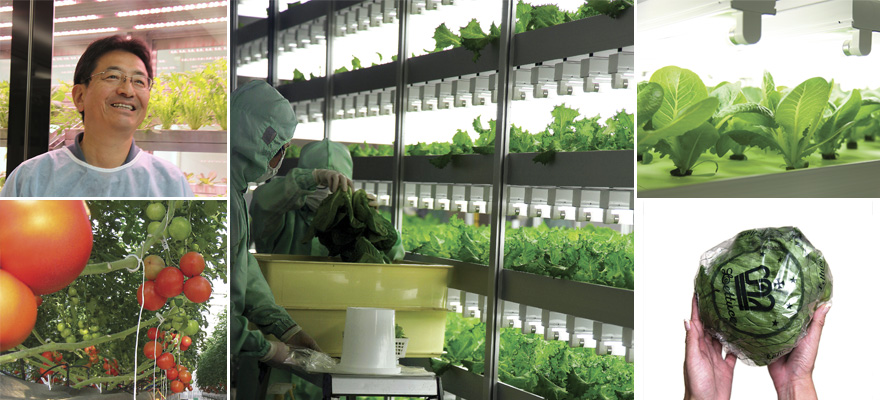Home > Highlighting JAPAN > Highlighting Japan August 2013 > Plant Factories
Highlighting JAPAN
Science & Technology
Plant Factories

With the anxieties surrounding food self-sufficiency and global climate change, urgency has been given to farming and harvesting techniques that allow for greater environmental control. These agricultural manufacturing systems are known as "plant factories". At Chiba University's Kashiwanoha Campus, this innovation makes ideal food production in Japan possible through environmental control, extensive planning and management of plants traditionally dependent on natural inputs, so as to produce fresh vegetables in the face of an uncertain future and harsh environmental conditions.
Given the current global population already exceeds seven billion people and is expected to top nine billion by 2050, food production is likely to become a serious problem for future generations. Plant factories are being devised as one possible solution for potential food shortages and climactic variability. By building a controlled growing environment that can closely monitor such variables as temperature, light intensity, humidity, ventilation, and CO2 concentration, vegetables can be raised in near ideal conditions, allowing better planning, quality and productivity. The three types of lights used vary according to specification: natural sunlight in greenhouses, artificial lamps only, and auxiliary lamps used in unison with sunlight.
How does the plant factory differ from a greenhouse? The plant factory has a much higher degree of environmental monitoring and use of technologies to better control the various factors needed in growing vegetables. Moreover, it does not use soil for cultivation, but instead uses supplemental nutrients that are found in regular topsoil. It is a very high-tech solution to counter severe environments or agricultural adversity. The factories can also produce vegetables of higher quality than normal greenhouse farms.
Professor Toru Maruo of the Graduate School of Horticulture Research, Chiba University, oversees the plant factory project. His team is currently conducting experiments within five sunlight plant factories and two artificial light factories. The project is supported by the Ministry of Agriculture, Forestry and Fisheries and forms part of a consortium of over 60 private companies.
Productivity levels are remarkable. If leaf lettuce is planted in racks stacked ten high within a 1000m2 plant factory, 7500 heads of lettuce can be produced in a day or about 2.5 million per year. Compared to open-field cultivation, this is more than 100-times the annual production, with even great capacity for higher yields.
New kinds of light sources are being tried, including LED lamps. Since LED is more power-efficient, its adoption may help reduce the per-unit cost of production and promises to make artificial-light plant factories a cost-cutting bet for the future.
Whereas in the past the key objectives of hydroponic cultivation were largely "stable supply" and "food safety and security," these latest advances are enabling a more ambitious agenda. In recent years, the move has been toward producing "functional foods" through the precise control of nutrient and lighting inputs. For example, it is now possible to make low-potassium lettuce catering to people with kidney disease. This means that there is the potential for a stronger link between medicine and agriculture, thus ensuring that health needs are met in the coming century.
Reducing production costs is a current aim of the plant factory project. Professor Maruo said that the cost of one head of lettuce has fallen as low as 58 yen, but that further cost reductions must be introduced to make the factories profitable in Japan. Varying plant species and targeting specialized markets may also further assist in meeting these cost objectives. Furthermore, costs can be brought under control by reducing crop losses. Whereas the average farm aims to lose less than 50% of its crop, a plant factory can achieve losses of less than 5%.
Another advantage of plant factories is that they do not use pesticides, which reduces health risks, water usage for washing and overall labor costs. Moreover, such factories also have the ability to be built closer to cities, where the food is ultimately consumed, since they are environmentally self-contained. This further reduces distribution and transportation costs.
Plant factories are now being used in countries outside of Japan as well. Mirai, Inc. (President Shimamura Shigeharu from Matsudo, Chiba Prefecture) will soon build one in Mongolia, using artificial lighting and hydroponic cultivation in order to supply local restaurants and groceries. Since Mongolia's winters are very harsh, the plant factory will be able to provide fresh vegetables throughout the year. A similar set-up has been built in the Showa Base in Antarctica, a climate that is especially hostile for farming, so that Antarctic-based researchers can have yearlong access to fresh foods. Lastly, mini-plant factory home kits are now available for family use.
Several challenges still exist. Since this kind of plant cultivation is energy intensive, costs remain high and thus their share of the overall market remains low at this stage. Whatever uncertainty future climate change and adverse agricultural conditions may bring, the technologies to provide daily fresh vegetables and fruit production are now within reach.
© 2009 Cabinet Office, Government of Japan






